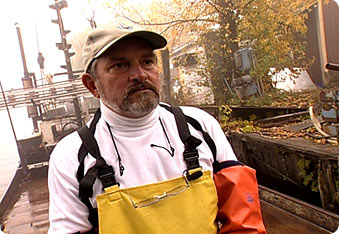
Paul Jensen shares a half-million pound commercial whitefish quota that is rarely met. Photo: Michigan Sea Grant
Fishing boats used to line Paul Jensen’s southern Lake Michigan dock. Now, recreational boats line his marina.
Three years shy of his family’s 100th year in the Lake Michigan whitefish industry, the Muskegon, Mich. fisherman said he’s hoping they’ll survive.
“The last few years we’ve basically set limited gear,” Jensen said. “We haven’t set as many nets as we’re licensed for, just kept our foot in the door.”
Jensen’s company, Marine Management Ltd., shares a half-million pound whitefish quota with neighbor Petersen’s Fisheries, but Jensen said they rarely meet it. The companies own the only two Michigan commercial fishing licenses for whitefish in the southern part of the lake.
Jensen has turned to other business with the unpredictability of catching the fish. The whitefish, the Great Lakes fishing industry’s most valuable resource, has gone through its own shares of ups and downs.
The largest decline in whitefish populations started in the 1940s, according to the Great Lakes Fishery Commission. The declines were mainly due to sea lamprey that preyed upon the whitefish and overfishing. The ebbs and flows of whitefish commercial catch mimic this trend.

An analysis of Great Lakes Fishery Commission commercial fish catch data from 1900 to 2006 shows that in the 1950s, average commercial whitefish catches decreased by more than 17 percent each year–fisherman saw their average catch drop from more than 10 million pounds of whitefish to about 6 million.
But when whitefish populations began to recover in the 1970s and into the late 1990s, the percent increase of average catches was more than five percent each year. The commission attributed this recovery to sea lamprey control, better commercial fishing industry management and introduction of salmon to control competition by smaller, plankton-eating fish and other factors.
Today, whitefish populations are variable in many parts of the lakes. The data shows that the commercial catch is beginning another decline. But one whitefish population has recolonized a historical spawning ground in the northern part of Lake Michigan said Scott Hansen, a fisheries biologist for the Wisconsin Department of Natural Resources at Sturgeon Bay.
Hansen said the population, found in the Menominee River, could be from a stock in Lake Michigan that migrated up to the water source, which borders both Michigan and Wisconsin.
Mark Ebener says revitalized populations have shown up in the Fox and Cedar Rivers that have been absent in those areas for the better part of a century.
“This recovery has been speeding up over the last decade or so in those tributaries,” said Ebener, an inter-tribal biologist with the Chippewa Ottawa Resources Authority.
But focus now seems to be on the quality, not the quantity of whitefish in the Great Lakes.

Some commercial whitefish fishers set fewer nets than they're licsensed for. Photo: Michigan Sea Grant
Fisherman threw whitefish of marketable length back into the Great Lakes in the 1990s because they had not reached the appropriate weight, according to a Great Lakes Fishery Commission technical report.
Scientists like Ebener are conducting studies to try and explain slower growth rates, smaller sizes and possible declines to reproductive efforts.
One idea correlates the decline of diporeia, a small shrimp-like organism and the whitefish’s nutritious main food source, with the arrival of zebra and quagga mussels. But populations of diporeia persist in areas where there are mussels, Ebener said.
“I think if we’ve learned anything, it’s that the changes in diporeia aren’t changing the whitefish populations,” he said.
He said whitefish are highly adaptable, eating whatever is abundant.
“It’s tough to describe whitefish diet because it changes so drastically depending on parts of lake,” he said.
Scientists have found populations in Lake Ontario shift diet from diporeia to quagga mussel, tiny clams and zooplankton.
In Lake Michigan where diporeia are no longer found in near shore areas, whitefish eat zebra mussels, gastropods like snails and midges, which are small insects.
Ebener thinks whitefish size, growth, age at maturity and reproductive success may have something to do with density dependence, in which fish decrease their size, slow growth or respond in other ways when a population becomes too large for a habitat’s food and resources.

Scientists are studying the effects of diet and disease on whitefish. Photo: Michigan Sea Grant
A third contributing factor in need of further investigation is the role of infectious diseases in the Great Lakes stocks of whitefish, though scientists have cited environmental change due to global warming as another possible factor.
A special supplement of the Journal of Great Lakes Research may help to answer some of the questions or spur new ones surrounding whitefish when it is published in the next few months.
The issue contains 15 of the latest scientific studies on whitefish population growth, natural mortality, reproductive efforts, diet and other characteristics. But debate still continues on what may be causing whitefish population changes and decreases in their condition.
Jensen said he will continue to tread water until they find an answer.
He’s made up for the uncertainty and expense of continued fishing through other businesses, such as boat building, mechanical and electronic work on research vessels and the marina.
“Time will tell,” he said.